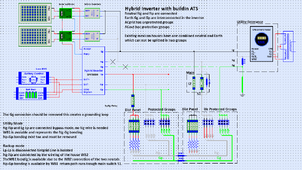Hi. Got a question about connecting the ACIN AND ACOUT neutrals as they are not connected when in solar or battery mode (sbu). I Only use utility mode when cloudy. I have them connected right now but want to make sure its safe. The reason they are connected is because of a tankless electrical water heater that has the hot line connected to the utility directly but the neutral line is connected to the rest of the home so that when the inverter is ON it takes the neutral from the inverter and when its off it takes its neutral from the grid. By connecting the INPUT and OUTPUT neutrals the water heater has the neutral and hot lines connected to the grid all the time even if the inverter is on.
So is it wrong having the inverter and grid neutrals both connected together while their hot lines are seperated or is it no problem? Why i want them connected is so that the electric water heater can work without me switching over to grid as it alredy has the hot line connected to grid and now because the inverter and grid neutrals are connected it works without switching.
Im on a 230v grid and it has been working for now but wanted confirmation from someone who knows better that its safe.
So is it wrong having the inverter and grid neutrals both connected together while their hot lines are seperated or is it no problem? Why i want them connected is so that the electric water heater can work without me switching over to grid as it alredy has the hot line connected to grid and now because the inverter and grid neutrals are connected it works without switching.
Im on a 230v grid and it has been working for now but wanted confirmation from someone who knows better that its safe.



